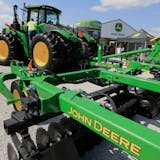The partners of Loup Ventures in Minneapolis have come up with a Robot Fear Index even though they aren't afraid of robots at all.
These venture capitalists envision a future with the technology of artificial intelligence, augmented reality, robotics and virtual reality used every day, by nearly everyone. So why publish an indicator of how much many of us fear that kind of future?
The best case, according to Loup managing partner Andrew Murphy, is that the index lets the firm track a gentle decline in fear of robots as people get more and more comfortable with automation. His worst case is that irrational fears escalate, yet by reporting on those fears his firm remains part of the public conversation and tries to help consumers better understand a topic that's often misunderstood.
A score of 100 means almost all of us are terrified, and their first ever calculation of the index landed at 31.5. The Loup Ventures robot fear index will be regularly updated, and Murphy said it's likely the index someday will rise, maybe driven by headlines of an incident like a self-driving car crash, before it drifts back down. As for now, an initial score of 31.5 suggests that we are cautiously at ease with robots.
A similar conclusion can be drawn from the last ranking of Americans' greatest fears, from an annual survey done at Chapman University in California. More than six in 10 of the respondents were afraid or very afraid of corrupt government officials, topping the list, while fear of "computers replacing people in the workforce" was near the bottom. Not quite 17 percent or so said they were afraid of that, about as many as were listed being afraid or very afraid of needles or a large volcano. Not that far away on the list was the fear of zombies.
Maybe one reason Americans are not that afraid of robots was suggested by Loup's first report on its index, the simple observation that robot technology isn't just in our future. It's all around us already.
In Loup's own survey, the partners found that more than two-thirds of respondents had used a digital assistant, like the iPhone's Siri, to dial their home telephone number in the previous three months. A similar percentage had used some sort of robotic technology, like maybe a robotic vacuum cleaner or toy.
Without even bothering to look closely, it's easy to see just how common robots have become, including in the daily flow of news across the desk,



